Sport fishing is a popular recreational activity among Missouri pond owners (Figure 1). Developing a farm pond for fishing requires several important decisions, including where to get fish; what species to stock; how many, what size and when to stock. Ponds stocked with incorrect combinations of fish can quickly develop unbalanced populations that will become a problem.
Small farm ponds and lakes are not natural environments, so they must be carefully managed. Successful pond management involves a combination of practices that promote a healthy and productive pond ecosystem:
- Ensuring during construction that a pond has enough watershed acreage to maintain water levels.
- Monitoring water quality, and adjusting as necessary.
- Ensuring food is available for fish.
- Controlling harvesting to maintain a balance of predator and prey populations.
- Managing aquatic vegetation, and controlling weeds.
- Preventing situations that may cause fish kills.
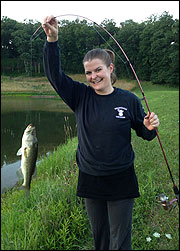 Figure 1
Figure 1
Species such as largemouth bass are a popular choice for stocking Missouri ponds and lakes.
Sources of fish
A variety of private commercial producers produce fish for pond stocking. Deal only with reliable fish hatcheries or producers to ensure fingerlings are healthy and to avoid introducing undesirable fish species, parasites or diseases into your pond. Consult MU Extension, Lincoln University, the Missouri Department of Agriculture or the Missouri Department of Conservation (MDC) for recommendations on reliable producers. The Missouri Aquaculture Directory, published by the Missouri Aquaculture Association, provides a list of reliable producers (see Additional resources).
MDC requires that pond owners keep receipts as proof of purchase for fish purchased or obtained from a private fish producer. Only species listed on the Missouri Approved Aquatic Species List may be stocked (see Additional resources).
Tips for selecting a fish supplier
- Ask if a short-term warranty is provided on purchased fish, and get a written agreement. Fish may be delivered alive but die soon after stocking due to poor handling, hauling stress, disease or insufficient tempering of pond water.
- Ask if the supplier produces the fish in its own facilities or buys them from a third party. Vendors who produce their own fish are more likely to know the health history of their fish.
- Ask what species and sizes they supply. Not all producers will sell the species you are interested in.
- Ask for references, and check them to learn if past customers have been satisfied with the vendor.
Fish stocking strategy
The choice of fish to stock will depend on your goals and available resources. Stocking can be divided into two general categories. Ponds of 1 acre or larger can be successfully stocked with a combination of largemouth bass, bluegill and channel catfish (Figure 2). In ponds smaller than an acre, bass and bluegill populations can be hard to manage. Stocking a single species such as channel catfish or developing a hybrid bluegill or sunfish fishery in combination with channel catfish are better options for small ponds. These species will have to be restocked regularly as they are harvested (Figures 3 and 4).
Stocking recommendations for establishing a balanced sport fish population are based on information from years of research by the Missouri Department of Conservation. For the best fishing, you must stock these fish in the proper ratios. Incorrect fish stocking may result in unbalanced fish populations and affect the production of harvestable fish.
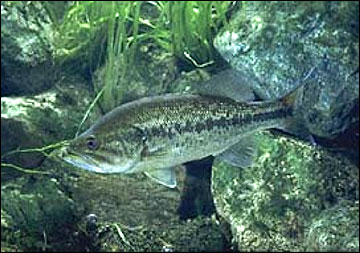
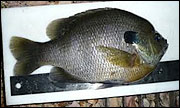
Figure 2
Stocking the correct numbers of largemouth bass (left) and bluegill sunfish (right) in ponds larger than an acre will help ensure a balanced fishery and provide excellent angling opportunities for years.
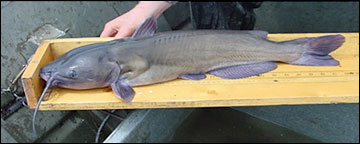 Figure 3
Figure 3
Channel catfish can be stocked in ponds with largemouth bass and bluegill or as a single species in smaller ponds. They will reach harvestable size in two to three years.
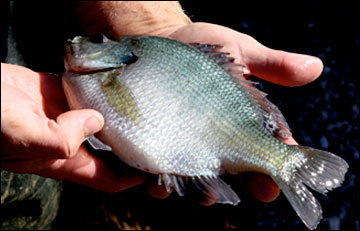 Figure 4
Figure 4
Hybrid sunfish can be stocked in small ponds for angling opportunities. They will need to be restocked regularly as they are harvested.
Estimating pond size
You need to know the acreage of your pond to determine the recommended numbers of fish to stock. MU Extension publication G9474, Pond Construction and Management Considerations; MDC's Missouri Pond Handbook; and other publications listed under Additional resources provide information on estimating pond size.
Consider the following fish stocking options when determining what types of fish you want in your pond.
Stocking fish for ponds 1 acre or larger
Largemouth bass and bluegill are a common combination for stocking ponds in Missouri. A healthy pond has a balance of predator and prey species, and bass and bluegill provide this balance better than any other combination of species in ponds larger than an acre. This pairing also allows you to add a few other species, such as redear sunfish, channel catfish and fathead minnows, to provide additional fishing opportunities and supplemental forage. Grass carp may also be stocked if the pond has an aquatic weed problem that needs to be controlled.
When stocked at recommended rates and properly managed, these species can provide years of good fishing. The recommended rates allow for healthy fish growth and provide enough fish to allow for taking some without hurting your pond's future fishing (Table 1). Stock all species except bass in the fall, when the pond is half full and filling. Stock bass the next spring.
- Stocking at lower densities is recommended in some counties due to a lack of adequate soil fertility. (Refer to the Missouri Pond Handbook for county-specific recommendations.) Stocking at higher densities in these locations usually results in slow growth and small populations of all fish species.
- No additional stocking should be necessary after the initial stocking of bass, bluegill or redear if you follow harvest recommendations to maintain a balanced population of these species.
- Channel catfish will not reproduce well in ponds stocked with bass, so they will need to be replaced after they have been harvested.
- Fathead minnows are optional for ponds stocked with bass but provide extra food to promote faster growth. They will be eaten quickly and must be restocked annually.
- Grass carp may be included at a rate of five per acre, in most cases, to prevent excessive aquatic weed growth. Consult a fisheries biologist or extension specialist before stocking grass carp in your pond.
Fingerling sunfish, such as bluegill and redear; catfish; grass carp; and fathead minnows can be stocked in the fall and early winter. Stock 500 bluegill sunfish fingerlings per acre or, if desired, a combination of 350 bluegill and 150 redear sunfish per acre (Figure 5). You can also stock 100 channel catfish fingerlings, 4 to 6 inches long, per acre if you are interested in adding another species to the pond for angling. Fathead minnows can be stocked at 3 pounds per acre to provide an additional source of forage.
Stock 100 largemouth bass fingerlings per acre in May or June of the next spring. The sunfish and fathead minnows will be getting ready to spawn at that point, which will help ensure prey are available for young bass. Largemouth bass prey on a variety of species, including small fish, frogs, crayfish and insects. Bass will spawn once a year in ponds and small lakes in Missouri. Where prey are plentiful, bass will grow rapidly, reaching 3 to 5 inches their first summer and up to 15 inches after three years. In Missouri, they reach spawning size at 10 to 12 inches, usually when they are between one and two years old.
Crappie are also a popular sport fish, but they rarely thrive in small ponds and lakes and should generally only be added to lakes larger than 50 acres. Crappie compete with bass for food, and they spawn earlier in the spring than bass and bluegill, meaning they will compete with young fingerlings for forage. Additional forage, such as fathead minnows, must be added continually to avoid stunting the growth of crappie and largemouth bass. Bluegill spawning will be unsuccessful if too many predator fish are stocked in the pond. If you stock crappie, the best plan is to stock hybrids of black and white crappie so their reproduction will not outpace the small bass.
Table 1
Recommended stocking rates and species combinations for ponds larger than 1 acre.
| Stocking combinations | Number of fish fingerlings per surface acre | ||||
|---|---|---|---|---|---|
| Largemouth bass | Bluegill | Redear sunfish | Channel catfish | Fathead minnows | |
| Bass and bluegill | 100 | 500 | — | — | 3 pounds |
| Bass, bluegill and catfish | 100 | 500 | — | 100 | 3 pounds |
| Bass, bluegill and redear | 100 | 350 | 150 | — | 3 pounds |
| Bass, bluegill, redear and catfish | 100 | 350 | 150 | 100 | 3 pounds |
 Figure 5
Figure 5
Redear sunfish fingerlings can be stocked with bluegill.
Stocking fish for ponds 1 acre or smaller
Stocking combinations of largemouth bass and sunfish is less successful in ponds smaller than an acre. Sunfish populations increase too fast for any individual fish to grow to a harvestable size. Additionally, bass can easily be overharvested in small ponds and do not provide enough pressure on sunfish populations to keep them in check. However, several stocking options work well in these smaller ponds if managed correctly.
For ponds managed specifically for recreational fishing, you can stock 50 largemouth bass, 50 channel catfish and either 500 bluegill sunfish or a combination of 250 hybrid sunfish and 250 bluegill per acre. Catfish will need to be restocked regularly. You can also stock fathead minnows for added forage at 3 to 5 pounds per acre. Alternatively, you can stock 150 redear sunfish instead of the bluegill.
Channel catfish can be stocked in smaller ponds at 200 fingerlings per acre, but they will require supplemental feeding. Hybrid sunfish stocked at 500 fingerlings per acre are also an option, particularly if the pond will be fished frequently.
Additional tips for success
- Portions of the pond should be at least 8 feet deep so fish populations have a refuge from higher water temperatures and dry conditions in summer.
- Exclude livestock with a permanent fence if the pond's surface area is smaller than 5 acres.
- Construct dams for permanence and water tightness; drainage areas should be adequate for water storage, but not excessive.
- Other than fathead minnows, no fish should be in the pond before fingerlings are stocked.
- Three species are recommended for Missouri ponds: bluegill, largemouth bass and channel catfish. Channel catfish are not necessary to maintain a balanced population, but they add fishing opportunities. Some specialty species may be added once the three species are established.
- A sound management program will yield years of good fishing. Fishing and harvesting are vital to ensure a balanced fish population. You can find additional information on managing for balanced fish populations in the Missouri Pond Handbook and in other publications in this extension series.
- Avoid stocking crappie, bullheads, common carp or green sunfish. These species will compete with bass and bluegill for limited food and other resources.
- Ponds with undesirable species or poor quality populations can be renovated by removing all fish with rotenone, a chemical used to kill fish. Seek professional advice from fishery biologists with the Missouri Department of Conservation before implementing a pond renovation program.
Conclusion
Properly constructed and managed ponds and lakes are valuable resources that can provide opportunities for aquaculture production or recreational sport fishing. An understanding of basic pond and fisheries ecology can help you accomplish your management goals.
Key considerations when planning your fish stocking program are the expected fishing intensity and the fertility and condition of the pond. The size of the watershed is also important; ponds should have 10 to 20 acres of watershed for each surface acre of water. Ponds with smaller watershed-to-surface-water ratios are harder to manage because water runoff is inadequate to keep the pond filled at crucial times of the year.
In a properly managed pond, natural spawning and growth will replenish bluegill and bass populations diminished by fishing. Catfish and hybrid sunfish will not reproduce in ponds, so they will need to be restocked annually or as they are harvested. Good fishing is not guaranteed, but careful management greatly improves the chances of it. Once a pond is stocked with the proper ratio of fish, maintaining good water quality and keeping vegetation under control will help ensure good fishing.
For additional information and technical help, contact a fisheries biologist with the Missouri Department of Conservation. Your local MU Extension center can also provide information and help with managing your pond for fishing, aquaculture, irrigation or recreational uses.
Additional resources
- Missouri Approved Aquatic Species List [Missouri Wildlife Code, 3 CSR 10-9.110(3)(H)]
- Missouri Department of Conservation publications:
- MU Extension and Lincoln University aquaculture and fisheries guides
- USDA Southern Regional Aquaculture Center publication series
Photo credits: Charles Hicks, Robert A. Pierce II, and the Missouri Department of Conservation